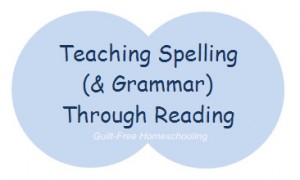I despise the way spelling is taught. I managed to get through the spelling workbooks that I had in school only because I was a word puzzle aficionado. When it came time to teach spelling to my own children, I became terribly frustrated. They did not instantly share my fascination for words or word puzzles. In fact, they found spelling workbooks to be very confusing and incredibly boring.
I remember spending hours as an early reader compiling my own lists of rhyming words and noticing that foot and boot appeared the same, but did not sound the same, which generated more lists. Writing all the possible combinations of certain sounds led me to a deep understanding of phonics rules and their applications. Exploration of prefixes and suffixes took me even further.
The public school method of test and retest used in the books we tried simply did not teach how to spell. Over the years, we abandoned the workbook pages and came up with our own methods for a spelling class. I emphasized prefixes, suffixes, Greek and Latin roots, and spelling patterns. Too often, the published spelling curricula grouped together words with nothing in common, ignoring the obvious patterns to be found.
I think that focusing on those patterns is an excellent way to learn spelling. Public school teachers have been told repeatedly in their college training classes that there are too many exceptions to too few rules. I disagree. I found a marvelous book called The ABC’s and All Their Tricks, which shows the patterns, the words sharing those patterns, and explains the origins of those patterns. It is a wonderful reference work — which finally explained to me how “w” can be used as a vowel.
Your lists of words can follow phonics rules or come from pre-prepared lists, such as the weekly lists found in spelling workbooks or from grade-level-specific lists. Another possibility for the avid reader is to compile his own list of unfamiliar words from his regular reading. Encourage your student to look up those words in the dictionary for origin, meaning, and pronunciation, and then incorporate them into your own customized spelling and vocabulary study program. My son expanded his own vocabulary by routinely browsing through the dictionary looking for new words.
My personal preference for learning a list of words would be to print out the chosen list (the time period for learning the words should be based upon your student’s ability) and post it in a prominent place where it will be seen multiple times throughout each day. Study the spelling patterns and then use repeated observation to cement the correct spelling into the brain. The student can use those words as the basis for exploring various art mediums: alphabet rubber stamps, calligraphy pens, or paper collage (cut and paste letters from newspapers and magazines). Bring out the letter tiles and cards from various table games and assemble all of the words from the current spelling list. If you have students who share my love of word puzzles (bless them!), challenge them to create their own puzzles — making the puzzles will teach much more than simply solving a puzzle will.
Daily observation can teach much more than we realize. Frank Gilbreth, the real-life father of Cheaper by the Dozen fame (stick with the book or 1950’s movie), painted information on the bathroom walls for his children to absorb while they performed their daily bathing and brushing rituals. After completing Morse code charts, Dad painted silly coded messages in various places around the house, fully expecting his children to translate them — and they did.
Repetition and drill by themselves are painfully boring, but when used creatively can become an enjoyable way to learn without wasting endless hours in rote memorization. Use what you have around your house and come up with clever new ways for your students to study the words they are learning.




 Guilt-Free Homeschooling is the creation of Carolyn Morrison and her daughter, Jennifer Leonhard. After serious disappointments with public school, Carolyn spent the next 11 years homeschooling her two children, from elementary to high school graduation and college admission. Refusing to force new homeschooling families to re-invent the wheel, Carolyn and Jennifer now share their encouragement, support, tips, and tricks, filling their blog with "all the answers we were looking for as a new-to-homeschooling family" and making this website a valuable resource for parents, not just a daily journal. Guilt-Free Homeschooling -- Equipping Parents for Homeschooling Success!
Guilt-Free Homeschooling is the creation of Carolyn Morrison and her daughter, Jennifer Leonhard. After serious disappointments with public school, Carolyn spent the next 11 years homeschooling her two children, from elementary to high school graduation and college admission. Refusing to force new homeschooling families to re-invent the wheel, Carolyn and Jennifer now share their encouragement, support, tips, and tricks, filling their blog with "all the answers we were looking for as a new-to-homeschooling family" and making this website a valuable resource for parents, not just a daily journal. Guilt-Free Homeschooling -- Equipping Parents for Homeschooling Success!

Recent Comments